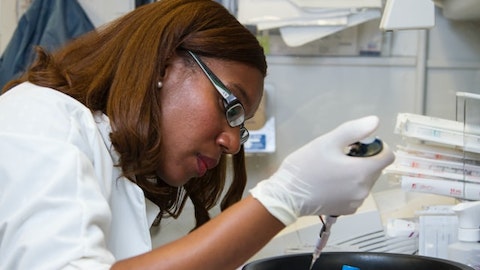Omnicell, Inc. (NASDAQ:OMCL) Q3 2023 Earnings Call Transcript November 5, 2023
Operator: Good morning, my name is Jordan, and I’ll be your conference operator today. At this time, I’d like to welcome everyone to the Omnicell Third Quarter Earnings Call. I’ll be turning the call over to Kathleen Nemeth, Senior Vice President of Investor Relations. [Operator Instructions] Kathleen, the floor is yours.
Kathleen Nemeth: Thank you, operator. Good morning, and welcome to the Omnicell third quarter 2023 financial results conference call. On the call with me today are Randall Lipps, Omnicell Chairman, President, CEO and Founder; and Nchacha Etta, Executive Vice President and Chief Financial Officer. This call will contain forward-looking statements, including statements related to financial projections or other statements regarding Omnicell’s plans, strategy, objectives, goals, expectations, cost savings actions or outlook that are subject to risks, uncertainties and other factors that could cause actual results to differ materially from those expressed or implied. For a more detailed description of the risks that impact these forward-looking statements, please refer to the information in our press release issued today in the Omnicell annual report on Form 10-K filed with the SEC on March 1, 2023, and in other more recent reports filed with the SEC.
Please be aware that you should not place undue reliance on any forward-looking statements made today. All forward-looking statements speak only as of the date hereof or the date specified on the call. Except as required by law, we do not assume any obligation to update or otherwise release publicly any revisions to our forward-looking statements. Our results were released this morning and are posted in the Investor Relations section of our website at ir.omnicell.com. Additionally, we would like to remind you that during this call, we will discuss some non-GAAP financial measures. Reconciliations of these non-GAAP measures to the most comparable GAAP financial measures are included in our financial results press release issued today. With respect to forward-looking non-GAAP measures, we do not provide a reconciliation of forward-looking non-GAAP measures to the comparable GAAP measures on a forward-looking basis as these items are inherently uncertain and difficult to estimate and cannot be predicted without unreasonable effort.
With that, I will turn the call over to Randall. Randall?
Randall Lipps: Good morning, and thank you all for joining us today. Today, I’ll walk through our high-level performance for the quarter, including our key customer wins and near-term and long-term trends we are seeing for our business and in the industry. We will provide an update on our outlook for the remainder of 2023, as well as introduce our preliminary thoughts on what we expect in 2024. Let me begin with our results, which we believe reflects solid performance and continued financial discipline from the Omnicell team. Throughout the third quarter of 2023, we continued to focus on advancing our strategy to transform the pharmacy care delivery model and deliver mission-critical medication management solutions for our customers globally.
We achieved the high end of our third quarter 2023 guidance ranges for total product and service revenues, and we exceeded our non-GAAP EBITDA and non-GAAP EPS target ranges. We generated total revenues of $299 million, non-GAAP EBITDA of $41 million and non-GAAP earnings per share of $0.62. We believe these results were primarily driven by our prudent approach to managing the business. Now turning to the market environment and what we are currently seeing in the overall health care industry. As evidenced by our customer wins, which we will detail shortly, we are pleased that Omnicell’s products, software and tech-enabled services appear to be resonating with the market. However, our health system customers continue to face challenges and seem to be showing signs of caution when implementing new workflows that may stress already thinly stretched nursing and IT staff, in turn, impacting the potential timing of new capital and software projects.
As we continue to work through our XT upgrade cycle, we are seeing moderation in our bookings and subsequently in our revenue as it relates to point of care. While we remain bullish on our Advanced Services and achieved a strong quarter in CPDS, point of care still makes up the majority of our revenue. We are also seeing headwinds for our IVX systems due to regulatory requirements. However, customer interest in our IV solutions remain robust. That said, we continue to believe Omnicell is part of the solution for the industry. As hospital P&L pressures should alleviate and the macroeconomic environment should improve, we expect Omnicell will be well positioned to capture incremental market share. Additionally, we continue to believe that the need to automate, optimize and modernize is more important than ever.
Our technology and innovative solutions are designed to help our customers achieve their long-term goals. And we believe today’s industry challenges, while currently a near-term headwind, will become a long-term tailwind for Omnicell. Now let me provide an update on our recent acquisitions. ReCept, now called Omnicell Specialty Pharmacy Services, FDS Amplicare and MarkeTouch Media. Throughout the third quarter, we continued to focus on executing our go-to-market strategy, building on our momentum from the first half of the year. We are pleased with our progress to date. With our robust portfolio, we believe that we remain uniquely positioned to continue to support pharmacy operations across the entire continuum. Turning to the customer landscape and our recent customer wins.
Customers continue to choose Omnicell in the third quarter, which we believe further demonstrates the important role we’re playing and automating and modernizing global medication management infrastructure. Beginning with customer wins for Advanced Services, our central pharmacy dispensing services continues to gain market traction with several health systems choosing to automate their central pharmacy inventory and dispensing operations. Customers appear to be recognizing the benefit to patient safety and workflow efficiencies of automating central pharmacy operations through a comprehensive solution, encompassing advanced robotics, dispensing optimization tools and expert services. As you may have seen, today, we announced that Kentucky-based Baptist Health has selected our central pharmacy dispensing service in an effort to alleviate staffing challenges and improve clinical and financial outcomes such as quality, patient safety and efficiency.
Baptist Health has been a leader in embracing the industry vision of a fully autonomous pharmacy, and we’re pleased to partner with them to help them move closer to that vision. In EnlivenHealth, we appear to be gaining momentum with cross-selling and upselling communication solutions to existing customers. We also launched our digital medication guides that are designed to digitize medication and vaccine information sheets, and we are seeing significant customer interest in this solution. We believe that these guides will improve medication literacy, adherence and reduce environmental waste. Importantly, health systems continue to choose Omnicell as a long-term partner for their pharmacy technology strategy as evidenced by several customers extending their sole source agreements, with one competitive conversion achieved this quarter.
This includes a Florida-based health system that plans to replace their existing point-of-care footprint with Omnicell XT systems. Recognizing the potential value in delivering secure solutions in the pharmacy supply chain, one of Georgia’s largest health care networks will be adding Omnicell’s inventory optimization service that is designed to improve visibility to and optimization of their medication inventory in an effort to reduce waste, expirations, stockouts and shortages. As health systems extend pharmacy care beyond the four walls of the hospital, one of our focus areas has been to expand the solutions and value we bring to the outpatient setting. Omnicell’s specialty pharmacy service offering should provide a revenue-generating opportunity while helping to support important patient care outcomes.
Omnicell’s management service expertise appears to be driving significant savings for this rapidly growing area of health care. As such, we want to share some results that the President and CEO of Temple University Hospital, Abhinav Rastogi, presented at our ILLUMINATE live event recently. We think the results they had seen thus far, while they may not be representative of all our customers, are certainly compelling. After implementing Omnicell’s specialty pharmacy services, Temple University Hospital saw 97% of its patients receiving access to limited distribution drugs. That’s a 183% increase in providers serviced and 457% growth in patient volume year-over-year. Omnicell has strong customer relationships. We have a strong position in the market, and our team is implementing many initiatives across the business that are expected to drive long-term growth.
That said, as we look ahead near term, we continue to face challenging industry dynamics and macroeconomic conditions. We are taking and will continue to take steps to reduce discretionary spending within the business. To bring our cost structure in line with near-term revenue expectations, we are building on our expense containment initiatives already underway and reducing the company’s headcount across a majority of our business functions. This is expected to result in approximately 7% reduction in our workforce. At the same time, we are focusing on closely managing costs. We will continue to advance our innovation agenda, which is focused on solving the biggest challenges in pharmacy care delivery. To that end, we are excited about our potential opportunities for expansion within specialty pharmacy.
The good traction you’re seeing with our robotic central pharmacy dispensing services and our ability to offer new services and solutions that are designed to optimize our large installed base of XT systems. I want to emphasize that our team has worked hard to architect a strategy that is designed to fundamentally transform the pharmacy care delivery model globally. Omnicell is profitable with deep customer relationships and strong brand and customer loyalty. And we believe the company is uniquely positioned to transform the pharmacy care delivery model. As we move into the next phase of our evolution, we believe our long-term opportunities are compelling, and we remain confident that Omnicell is well positioned for the future. With that, I’ll turn the call over to Nchacha, who just completed his first full quarter with us at Omnicell and has done an excellent job leading our financial organization as we work to drive operational efficiencies across the business.

Nchacha?
Nchacha Etta: Thanks, Randall, and thank you all for being here today. Let me start by expressing my deep appreciation to the Omnicell team who have made my transition into the Chief Financial Officer role as smooth as possible over the past four months. They are a team of incredibly talented professionals who are passionate about and fully committed to working to deliver on our long-term strategy of transforming the pharmacy care delivery model. We have a long history of profitability, and our team remains laser-focused on building on our strong track record to deliver for our stockholders. Having settled in my role in the last few months, I have now spent a considerable amount of time speaking with our global teams, numerous customers and other key stakeholders to learn more about the ins and out of our business, while bringing my own fresh perspective regarding how we manage the business.
I have taken a deeper look at our financials and how we are planning and forecasting. I have given a lot of thought to how I think we can strengthen and refine certain processes. And I’m committed to further advancing our existing processes. Today, I will discuss our third quarter financial performance, the current demand environment, and our fourth quarter and full year 2023 outlook. I’ll also provide an initial perspective on 2024, which will be high level and qualitative because we are in the early stages of our 2024 planning. I would like to begin with an overview of our financial results for the third quarter. Our third quarter 2023 total GAAP revenues were $299 million, near the top end of the previously provided guidance range, reflecting strong execution within the quarter.
Total revenues in the quarter were down 14% compared to the third quarter of 2022, reflecting lower point of care revenues, primarily as a result of ongoing health care system capital budget and labor constraints. Services revenue were $110 million, an increase of 8% versus the third quarter of 2022, primarily driven by growth in Advanced Services, continued growth in our installed customer base, as well as the impact of pricing actions. Non-GAAP gross margin for the third quarter 2023 was 45.7%, a decrease of 110 basis points from the prior quarter, primarily due to the continued investment in services as we scale our Advanced Services solutions and make investments in technical services to support our customers. For some of our Advanced Services, we are required to hire pharmacy technicians and experts well in advance of implementation.
A full reconciliation of our GAAP to non-GAAP results are included in our third quarter 2023 earnings press release, which is posted on our Investor Relations website. Our third quarter 2023 earnings per share in accordance with GAAP were $0.12, compared to $0.08 per share in the prior quarter and $0.37 per share in the third quarter of 2022. Our third quarter 2023 non-GAAP earnings per share was $0.62, compared to $0.57 per share in the prior quarter and $1 per share in the same period last year. Our third quarter 2023 non-GAAP EBITDA was $41 million, a decrease of $6 million compared to the previous quarter, generally reflecting continued investments in services. Our third quarter 2023 non-GAAP EBITDA and non-GAAP earnings per share exceeded the guidance range substantially due to a strong cost management.
At the end of the third quarter 2023, our cash balance was $447 million, up $48 million from $399 million as of June 30, 2023, reflecting strong cash collections and free cash flow within the quarter. We recently completed the refinancing of our revolving credit facility, downsized to $350 million, which was oversubscribed, and which we believe indicates our lenders’ confidence in our business model, strong balance sheet and a disciplined financial management approach. We are mindful of the upcoming 2025 maturity of our convertible senior notes and are considering various options to maintain strategic flexibility for our company, and attempt to minimize potential dilution for our shareholders. In the meantime, we believe we are in a very good position with the current convertible senior notes, which have a 0.25% coupon interest rate.
In short, we remain confident in our capital structure and our ability to support the ongoing execution of our growth strategy. Our accounts receivable days of sales outstanding for the third quarter of 2023 was 84 days, a decrease of one day over the prior quarter, reflecting continued strong cash collections. Inventories as of September 30, 2023, were $116 million, a decrease of $31 million from December 31, 2022. Our global supply chain team has made great progress in managing inventory levels throughout the year. Free cash flow during the third quarter of 2023 was $43 million, driven by strong cash collections. Now moving on to our full year and fourth quarter 2023 guidance. As Randall mentioned, we continue to see our customers be more cautious as they consider the change and training required to implement new workflows which could stress already thinly stretched nursing and IT staff.
This customer caution has affected the timing of some of our contracting and new capital as well as software project implementations. Additionally, we are seeing moderation of sales of our XT cabinets based on where we were currently in the XT upgrade cycle. As a result of these changes, we now expect the full year bookings for 2023 to range between $850 million and $950 million. While we are pleased with our strong performance through the first three quarters of the year, we are taking what we believe is a prudent approach to managing our business. We now expect our full year 2023 total revenues to range between $1.135 billion to $1.155 billion, a decrease to the guidance we provided on our second quarter 2023 earnings call. We now expect the full year 2023 product revenues to range between $705 million and $715 million, reflecting expected lower than originally planned levels of Connected Devices revenues in the fourth quarter.
Despite the lower bookings and product revenue guidance ranges, we continue to execute well within both Technical Services and Advanced Services. We now expect 2023 services revenue to range between $430 million and $440 million, an increase of $10 million compared to the bottom of the end of the guidance range provided on our second quarter 2023 earnings call. We expect Advanced Services revenue to be between $208 million and $213 million. This is a 13% increase at the midpoint compared to 2022, and approximately 18% of 2023 total revenues. We expect Technical Services revenue to range between $222 million and $227 million in 2023. This is an increase of 9% at the midpoint as compared to 2022. Please refer to our third quarter 2023 earnings release published on our Investor Relations website for a summary of the total year 2023 revenue guidance components.
We expect total year 2023 non-GAAP EBITDA to range between $123 million and $133 million, a decrease from the guidance provided on our second quarter 2023 earnings call. We expect 2023 non-GAAP earnings to be between $1.65 and $1.80 per share, a decrease from our previously provided guidance. The reduction of the range for the full year 2023 non-GAAP EBITDA and non-GAAP earnings per share compared to the guidance range we provided on our second quarter 2023 earnings call reflects the lower profit from the decrease in expected product revenue for the year. We continue to evaluate our cost structure and expect non-GAAP operating expenses to be down year-over-year. I’ll also speak in a moment about additional actions we expect to take in the fourth quarter and the anticipated associated charges and future savings.
For the full year 2023, we are assuming an effective blended tax rate of approximately 13% in our non-GAAP earnings per share. For the fourth quarter of 2023, we are providing the following guidance. We expect the fourth quarter 2023 revenues to range between $247 million and $267 million. We expect product revenues to range between $142 million and $152 million, and Services revenue to range between $105 million and $115 million. We expect fourth quarter 2023 non-GAAP EBITDA to range between $9 million and $19 million. And we expect fourth quarter 2023 non-GAAP earnings per share to range between $0.07 and $0.22. As Randall mentioned, today we also disclosed cost-containment actions we plan to take, including a head count reduction across our business or company.
We expect approximately $12 million to $18 million of nonrecurring restructuring and related charges to the cost containment plan we are taking. We expect to incur a majority of the changes in the fourth quarter of 2023 and substantially completed plan by the end of the second quarter of 2024, subject to local law and consultation requirements. We also expect $45 million to $55 million of annualized cost savings as a result of the cost actions, which around 75% is expected to be operating expenses. A majority of the benefits from the cost actions is anticipated to be realized beginning in the first quarter of 2024 with a smaller portion of the savings expected as we progress through the year. The cost actions should be partially offset by year-over-year increases in compensation and vendor price increases.
Now I will speak briefly about 2024. While it is too early to provide specific metrics, we want to share some considerations based on what we know today. We believe that giving you some insight into our expectation may help you with your financial models. We expect that our reduced bookings outlook for 2023 will have an impact on our revenues in 2024. While portions of our Advanced Services portfolio continue to deliver solid growth, it is not expected to be enough in 2024 to offset the decline we expect in our point-of-care revenue. Therefore, total revenues for 2025 are expected to decline modestly. Of course, we plan to provide our full 2024 outlook in the first quarter of 2024. As we hope is clear from the additional cost containment actions announced today, we are working to closely manage expenses to be in line with our top line expectations in an effort to offset the anticipated continuation of macroeconomic headwinds in 2024.
As I noted earlier, these are high-level preliminary remarks intended to assist with the 2024 financial modeling of our business. In summary, we continue to execute against our long-term growth strategy and deliver solid financial and operational results despite a declining macroeconomic environment. We are seeing challenges for our customers, including the impact of the macroeconomic environment and labor challenges. And we expect these headwinds to continue into 2024. We also expect bookings for our XT cabinets to continue to moderate. That said, we are confident that the approach we are taking to managing the business should position Omnicell to deliver on our commitments over the long term. The team has built a strong foundation from which we expect to continue our momentum in transforming the pharmacy care delivery model.
We are clear on the strategic direction for Omnicell, and we believe we are well equipped to get there. We remain focused on driving value for our shareholders as we look to execute on our strategy and work to capture the opportunities we see ahead of us as we endeavor to drive long-term profitable growth and success at Omnicell. With that, we would like to open the call for questions.
See also 10 Countries with Most Nuclear Weapons in the World and 15 States with the Best Roads in the US.
Q&A Session
Follow Omnicell Inc. (NASDAQ:OMCL)
Follow Omnicell Inc. (NASDAQ:OMCL)
Operator: [Operator Instructions] Your first question comes from the line of Stan Berenshteyn from Wells Fargo. Your line is open.
Stan Berenshteyn: Hi. Thanks for taking my questions and I appreciate the color on 2024. First, maybe on cost containment actions, you said it’s going to be across organization. But can you detail any particular areas you plan to focus on when thinking about these cost cuts?
Nchacha Etta: Stan, thanks for the question. So we’re looking at taking costs across the entire company. There are some specific areas where we believe we will see more costs taken out than in others. But primarily, we’re looking at our enabling functions where we think there are some inefficiencies, the areas where we will not look at taking out cost because they’re growth areas within our company. So for example, Advanced Services is one of the areas where we’re limiting the amount of cost takeout.
Stan Berenshteyn: Okay. That’s helpful. And maybe sticking with Advanced Services, can you share with us what products or services specifically under Advanced Services are contributing to growth in that segment?
Nchacha Etta: The specialty services continues to be a growth engine for our company. We’re also seeing some growth in some of the solutions and services that we’re providing in the retail space, but not as robust as specialty services.
Stan Berenshteyn: Okay. And then maybe one final question, on the bookings guidance. Any chance you can share with us what percentage of the mix of your guidance is product-related bookings?
Nchacha Etta: Yes. So I would say the majority of the – close to about 20% is related to the mix.
Stan Berenshteyn: I’m sorry, 20% is product bookings?
Nchacha Etta: No. Sorry, can you repeat the question?
Stan Berenshteyn: So the bookings that you’re guiding for this year, $850 million to $950 million, what percentage of that bookings is product-related bookings.
Randall Lipps: We don’t disclose that. We do – probably do a summation at the end of the year. So the best you could do is kind of look at our K from last year. But I would say that most of the headwinds in our bookings have been on the inpatient point of care.
Stan Berenshteyn: Okay. Thanks so much.
Kathleen Nemeth: Next question please.
Operator: Your next question comes from the line of Scott Schoenhaus from KeyBanc. Your line is live.
Scott Schoenhaus: Hi, team. Thanks for taking my question. First I wanted to talk about the macro. It seems like it’s a mix of both budget constraints and staffing shortages on the point of care side. What are your conversations with these hospital systems? Is it, once they get staffing levels up, they should be able to have enough capital to make these – execute on these orders? What is their conversations to you in regards to forward demand and the current environment at the hospital level?
Randall Lipps: Yes. I think the providers have the tough equation, right? Their revenues are fairly flat, payer contracts haven’t gone up much. So potentially next year, that will help a little bit. But labor costs have risen, and so have the volume. So particularly on inpatient is where most of the headwind is in these big providers. Outpatients, they’re actually doing a lot better. And so of course, point-of-care systems is primarily used in the inpatient world, and that’s where we have the strongest headwind. So the margins were squeezed due to the inflationary costs, the flatness of the revenue, and just the overall general increase in cost. And we, ourselves, we’re on the second half of our XT upgrade cycle. And customers need to upgrade, they have to upgrade, but there’s a lot of resistance there because of this inpatient macroeconomic headwind, that has improved slightly, stabilized and improved slightly, but not significantly.
Scott Schoenhaus: Okay. And then my next follow-up question is on the retail side. What are you seeing from your retail pharmacy customers? There’s obviously been a lot of headlines regarding store closures across all the big pharmacy chains. There’s been staffing shortages and staffing challenges there as well. Is this a headwind to EnlivenHealth?
Randall Lipps: Well, it’s a headwind, but it’s also an opportunity. Some of the services that drive more demand to pharmacies for medication management, sometimes that could be perceived as a headwind. But if you look at our communication solution set, it really takes workload off of pharmacists, to allow them to take fewer calls. And med synchronization also eliminates less visits to the pharmacy and allows more transactions to be consolidated. So that is also a big lift. And we’re also excited about our digital medication cards, notices that we give out, now we can give out with the pharmacists, which is also a big time saver and easier to administer for patients. So I think it’s a little bit of a mix. The headwinds do sometimes prevent the starting up of new services, but I believe most people look at these services as helping their pharmacy achieve what they want, which is more revenue, lower cost, more throughput.
Scott Schoenhaus: Thank you.
Operator: Your next question comes from the line of Jes Tassan from Piper Sandler. Your line is live.
Jes Tassan: Hi, guys. Thank you for taking my question. And thank you also for the 2024 just commentary. I want to start with Randall. I think you mentioned some additional regulatory requirements on the IVX. Our understanding was that this device was FDA approved in March ’22. So just would appreciate any comments on the additional regulatory hurdles on IVX and then time line to resolution?
Randall Lipps: Yes. I think it’s a complex situation because you not only have the FDA, which is national, you have local pharmacy boards in each state that also have to put their spin or interpretation of those FDA rules and what they will allow to be compounded or mixed with the robot on site or what they won’t allow. And so as those rules get clarified, then ROI calculations can be more accurately done for each installation, which gives them the confidence of how fast they want to progress with and the rollout of the robots. So some states are a lot clear, some aren’t. And it just takes time because people are, of course, conservative in these kinds of decisions as they move forward about regulations and what they can do and what they can’t do.



